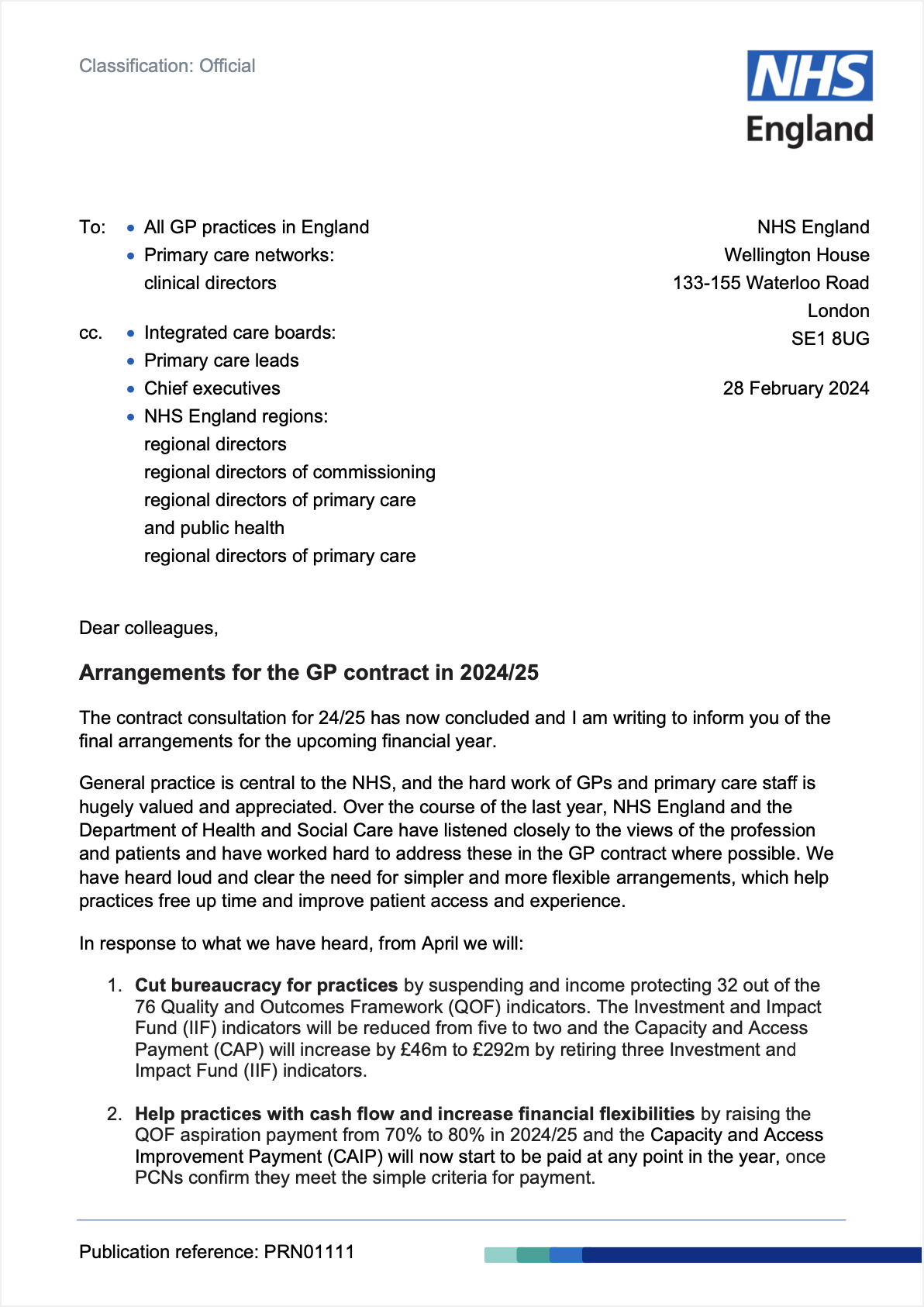In this article, Helen Holmes Fogg, Redmoor Health’s Director of Strategy and Development, shares her reflections on the new GP contract letter, offering insights from her extensive experience in guiding strategic initiatives within the healthcare sector.
On 28 February, NHS England released details of the arrangements for the GP Contract in 2024/2025. The letter provided updates on a number of changes including;
- Simplification of QOF and DES reporting to cut down on red tape.
- More flexible CAIP payment schedules to improve cash flow once specific criteria are met.
- Increased staffing flexibility through the ARRS scheme.
- Continued promotion of better patient access as the ‘Modern General Practice Access’ initiative moves into Year 2.
However, the funding increase for the GP contract is below inflation. As expected, this contract provides a second annual roll over as opposed to a customary five-year term, a decision likely influenced by the upcoming General Election.
It is easy to be controversial with a controversial document. But having spoken with several GPs and senior Primary Care leaders since the letter’s release, and reflecting through the lens of my 25 years of NHS experience, I’d like to unpack the potential impact of the new contract for Primary Care in the upcoming year.
I always try and take a balanced view; however, it is difficult for people in the NHS to find positives when the overall position of this letter is stagnation. I know from speaking to colleagues in general practice that the sector was praying for something positive and stabilising, but unfortunately this hasn’t materialised. Not having a long-term view at the same time as being quite chaotic, is resulting in most decisions being made to balance the workload and finances as opposed to a sound plan for supporting the work needed to generate real change in the NHS.
There has been some letting go of specific targets, likely to mitigate the expected reaction to its contents but overall, this letter leaves provider services and commissioning in a position where they can’t plan forward without reasonable and untenable risk.
There is quite a lot of operational information to unpack, which other members of our team are working on to support both in commissioner and providers that Redmoor Health works with. Here are some of the broader points:
2% pay uplift: There has never been an expectation in primary care of copious surplus cash but given the demands in this letter for further activity with no more income and colleagues in other segments striking, the sector is disillusioned, and one could even say angry. In what other industry or sector would you see this increase in expectation without the means to sustain it? The BMA is holding a firm line on this – will we enter into more strikes as a result?
Better Patient Access vs Continuity of Care: There is a continuation of the focus on improving patient access but an acknowledgement of long-term continuity of care. This has been coupled with a reprieve in QoF and IIF targets for areas that have been reduced to pool what resourcing there is into more focussed areas.
Digital: Recovery and access are a pivotal focus for digital access and there is a direct requirement for the use of cloud-based telephony implementation and the telephony data capturing activity. This on the whole is positive – we should expect patients to be able to access NHS services as they do with other out-of-sector services. This focus will bring general practice up to date with the general public’s expectations and hopefully reduce negative patient feedback.
Mental Health: This is still rightly in the spotlight. However, reports this past week have highlighted that people in their 20s are more likely to be suffering from poor mental health than those in their 40s. Community mental health services have had significant cuts and secondary care services have been merged, leading to long waiting lists; as general practice is the gateway to the NHS, this is the area where our younger adults need more support.
Collaboration: Opportunities for improving patient services and improving workforce conditions will be available for GP practices working collectively with their PCN, GP Federations and wider stakeholder services. Identifying patient population health segments and using the various expanded roles within the general practice will hopefully create ways of working which are both GP-led and make good use of the various additional roles and wider neighbourhood services.
Trust: Trusted and brave relationships, environments and leadership may start some grassroots revolutions which with a looser contract may be bold enough to act and do without waiting for permission first. Seize the initiative whilst it’s there folks!
Health inequalities: This is a way of reframing and refocusing on how we create the change that is needed to drive the NHS that is required for the way the public wants to access service.
In conclusion…
The short-termism of this letter is pushing commissioning into a position of counting beans instead of investing in something more planned, efficient and effective. The result of this for frontline staff, services, and population, is merged budgets, battening down the hatches (again!), and restrictions on providers’ ability to be creative and transformational at a time when this is needed more than ever.
Someone said to me this week, that there is no more money. No more GPs and nurses and no more ambulances. There is little use in counting the metrics which are telling us we aren’t progressing. We need to start looking through a different lens if we are to start providing better quality and outcomes-driven primary care. Data-driven population health stratification where we can segment our citizens provides a more person-centred approach to how we manage those who need long-term conditions.
Call me altruistic, but I have always held true to the premise that we need to create our own journey where at all possible. If we can’t do it alone, then we might need to join forces with our colleagues who are in the same boat.
Collaboration is one of the key strengths we can use to generate improvement and change.


Blog by Helen Holmes-Fogg
Helen has had a varied 22 year executive career in and around the NHS. Qualifying from UCLAN in Health Policy and Management, she worked as a senior operational manager designing and delivering urgent care, clinical triage and call handling services. She has been responsible for the implementation of electronic patient management systems and the first NHS111 face to face site at a vanguard Urgent Care Centre front-ending ED. She was part of the procurement team for the North West’s first NHS111 service alongside North West Ambulance Trust.
As Director of Strategy, Helen led the successful procurement of a Yorkshire Urgent Care System, leading to transformational service delivery. Over the past 5 years as the CEO of a GP Federation, she led the early formation of collaborative general practice. This grassroots revolution led the maturity and readiness for the introduction of Primary Care Networks. During this time, Helen’s team proudly developed a nationally recognised enhanced care home service. As part of the local health and care system, Helen chaired an integrated care provider group combining primary, community, allied services, and the voluntary sector, leading the local covid response programme.
Helen is naturally driven to connect people and services at a local or system level. She sees digital integration as the enabler of future health and care delivery.
Make an enquiry


